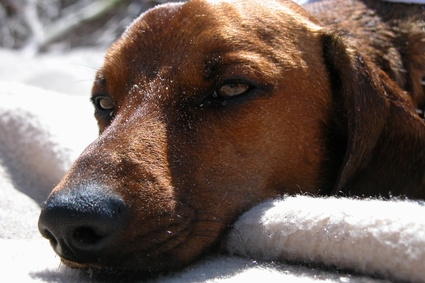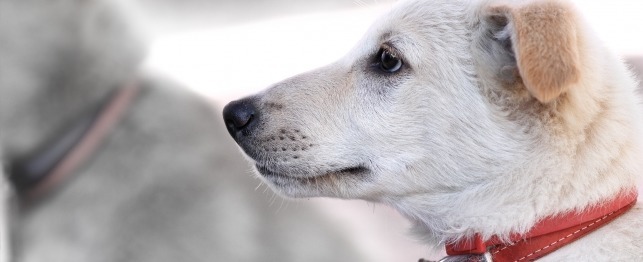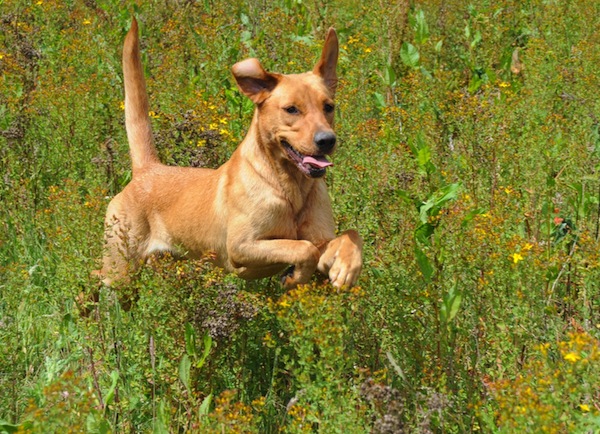An abnormal area of the body that loses fur, and perhaps leaks a fluid or becomes dry and patchy might indicate that your dog has dog hot spots. These skin lesions result from bacterial infestation of the area, but usually require some type of environmental cause that allows the bacteria to get a foothold. The technical term for these lesions is pyotraumatic dermatitis, and the underlying cause can be related to poor grooming, allergies, or behavioral issues.
A dog with a normal immune system does not develop spontaneous skin infections. Some kind of underlying cause is responsible for the development of these lesions in otherwise healthy animals. This underlying cause can be as simple as moisture buildup behind a mat of fur, or as complicated as self-mutilation due to excessive licking, brought on by an unknown mental issue.
It's always recommended to take your dog to the veterinarian, just in case the issue is more serious than it appears. After clipping the fur around the affected area, you or the vet will wash it regularly with a gentle antiseptic or other cleanser until it heals. Sores that were created by scratching or licking may require the use of an e-collar for a short period of time while the area heals.
Treating the problem behind the skin infection is important in making sure that the situation completely resolves. If only the end result is treated, these problematic spots will often recur. Determining the ultimate cause of the irritation is thus necessary for effective treatment.
Clipping matted fur and maintaining a regular grooming schedule will help dogs that get these irritated patches due to excessive fur. Long-haired dogs need to be groomed at least twice a week, and all the mats should be either untangled or clipped out during these sessions. Going to the groomers may be necessary for dogs whose owners cannot keep up with their grooming needs.
Allergic dogs can be allergic to almost anything they encounter regularly. Cleaning your dog's environment of as many of these possible allergens as is realistic is generally the first treatment. This requires treating for fleas, if any are present, treating the dog with a flea-preventative to avoid those that might be outdoors, switching to a lower-allergen food, and vacuuming to remove dust and pollen. Some dogs require an antihistamine, as well.
Behavioral issues can be complicated, both to understand and to resolve. Dogs that lick excessively are usually bored or anxious, and both of these problems can clear up with more exercise and mental stimulation, if the situation is mild. Dogs that are more strongly affected can benefit from a consult with a behaviorist, and extremely anxious dogs might require an anti-anxiety medication of some sort.
Dog hot spots indicate a greater problem that is manifesting as a skin infection. Clearing up the bigger issue is generally more complicated than resolving the skin infection, but is necessary in order to prevent recurrences. Getting proper treatment for underlying issues can make the difference between a happy dog and one that is miserable.

 8 IMPORTANT Tips to Keep Dogs Safe This Summer
8 IMPORTANT Tips to Keep Dogs Safe This Summe
8 IMPORTANT Tips to Keep Dogs Safe This Summer
8 IMPORTANT Tips to Keep Dogs Safe This Summe
 Homemade Dog Diapers
Homemade Dog Diapers
Homemade Dog Diap
Homemade Dog Diapers
Homemade Dog Diapers
Homemade Dog Diap
 Puppy Collars - Choosing a Collar for Your Puppy
Puppy Collars - Choosing a Collar for Your Pu
Puppy Collars - Choosing a Collar for Your Puppy
Puppy Collars - Choosing a Collar for Your Pu
 What Your 6-month-old Puppy Needs
What Your 6-month-old Puppy Needs
What Your 6-month-old Puppy Needs
What Your 6-month-old Puppy Needs
 Lyme Disease in Dogs: Symptoms, Testing, Treatment, and Prevention
What is Lyme disease?
Lyme disease
Lyme Disease in Dogs: Symptoms, Testing, Treatment, and Prevention
What is Lyme disease?
Lyme disease